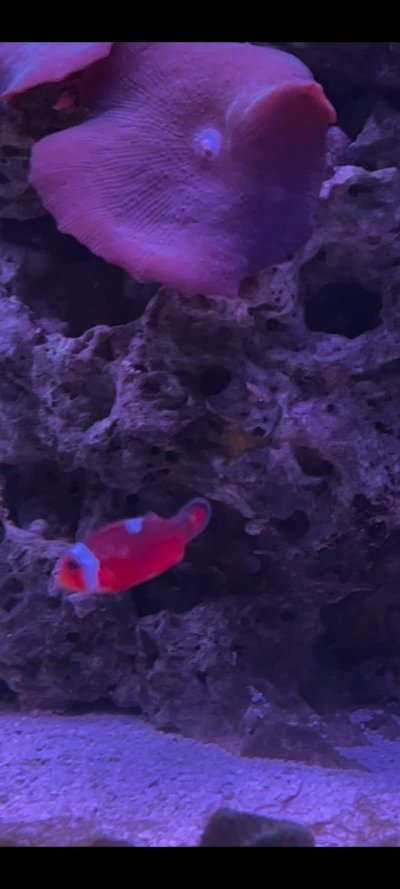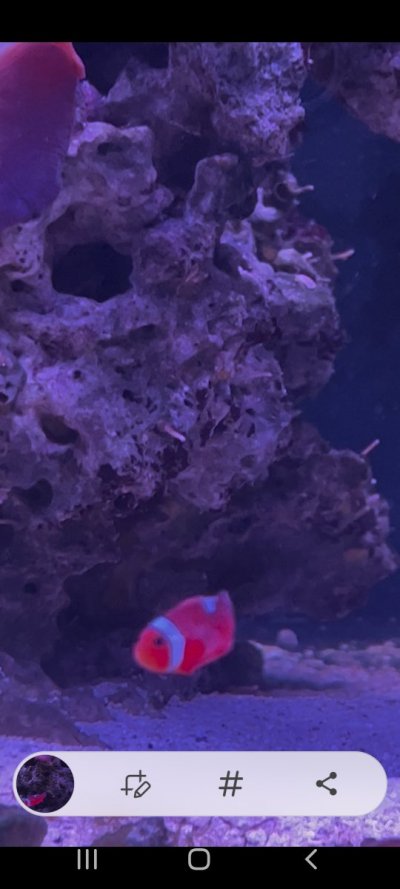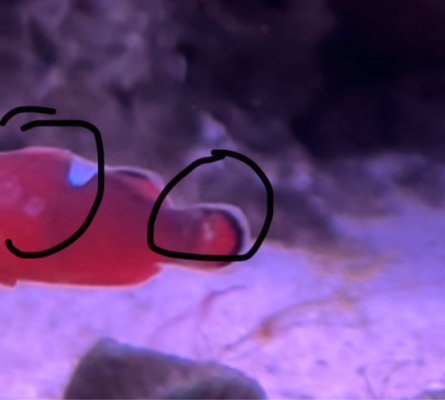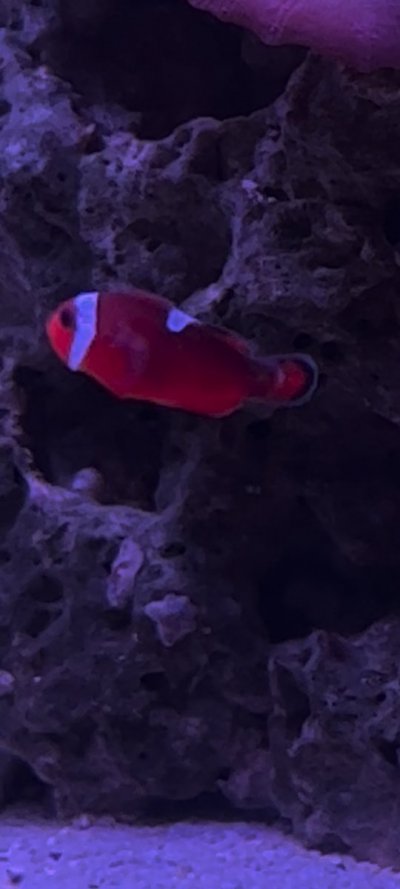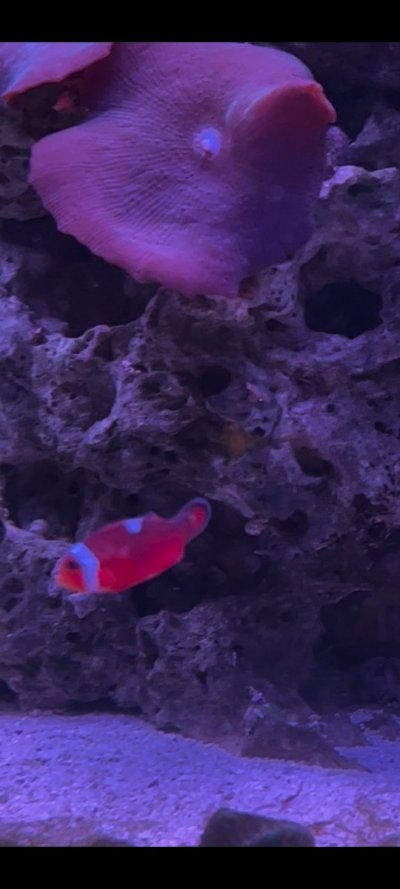Navigation
Install the app
How to install the app on iOS
Follow along with the video below to see how to install our site as a web app on your home screen.
Note: This feature may not be available in some browsers.
More options
You are using an out of date browser. It may not display this or other websites correctly.
You should upgrade or use an alternative browser.
You should upgrade or use an alternative browser.
IS THIS ICK?!?
- EMERGENCY
- Thread starter tinytanya7
- Start date
- Tagged users None
vetteguy53081
Well known Member and monster tank lover
View Badges
Partner Member 2024
Excellence Award
Reef Tank 365
RGB
Article Contributor
Tampa Bay Reef Keepers
West Palm Beach Reefer
Hospitality Award
Ocala Reef Club Member
305 Reef Club
Wisco Reefers
Midwest Reefer
Fish Medic
MAC of SW Florida
Rock Pool Reef Keepers
R2R Secret Santa 2023
My Tank Thread
My Aquarium Showcase
Can’t open video
Ick will look like the fish was sprinkled with salt and likely displaying rapid breathing, itching itself and lethargic behavior
Velvet will look like dust or solar system
Please if you can, post still pics under white lighting
Ick will look like the fish was sprinkled with salt and likely displaying rapid breathing, itching itself and lethargic behavior
Velvet will look like dust or solar system
Please if you can, post still pics under white lighting
Screenshots from video.looks like mucus peeling off.im no expert but would say research brook or velvet.
And give some more info for the experts like are they eating ,swimming into powrr heads and much info you can
And give some more info for the experts like are they eating ,swimming into powrr heads and much info you can
Attachments
I have not added any new fish or items and I’ve had these fish for 5 months. My two other clowns are white and I cannot see any white dots on them.
This one (Cheeto) is swimming very low to the ground and has these white spots. His mouth is starting to look white but he is still eating.
salinity 1.025
Amonia 0
Nitrate 20 (had a small clown die a few days ago)
This one (Cheeto) is swimming very low to the ground and has these white spots. His mouth is starting to look white but he is still eating.
salinity 1.025
Amonia 0
Nitrate 20 (had a small clown die a few days ago)
Attachments
Still looks to me like fish producing excess mucus and it peeling off.
If got 2 white clownfish now and this one in question plus you had a clown die and it raised your nitrates,that's 4 clowns and in video I see one white clownfish that looks considerably bigger so if other white one bigger and possibly was in tank first so established ?
If so then the 2 established clowns could be biting the 2 smaller ones to point where one has died and other stopped eating and fish producing more mucus because if getting bitten .
But excess mucus and slime coat peeling off could also be symptoms of diesese like brook but will let the more experienced reefers advise @vetteguy53081 @Jay Hemdal
Good luck with your fish .
You say you haven't a qt but if a fish has a parasite/diesese and you want your dt to house any kind of invert then it often means to not add medication to the dt especially copper so its best to medicate in a seperate qt tank or even a tote or plastic bucket.
If got 2 white clownfish now and this one in question plus you had a clown die and it raised your nitrates,that's 4 clowns and in video I see one white clownfish that looks considerably bigger so if other white one bigger and possibly was in tank first so established ?
If so then the 2 established clowns could be biting the 2 smaller ones to point where one has died and other stopped eating and fish producing more mucus because if getting bitten .
But excess mucus and slime coat peeling off could also be symptoms of diesese like brook but will let the more experienced reefers advise @vetteguy53081 @Jay Hemdal
Good luck with your fish .
You say you haven't a qt but if a fish has a parasite/diesese and you want your dt to house any kind of invert then it often means to not add medication to the dt especially copper so its best to medicate in a seperate qt tank or even a tote or plastic bucket.
Attachments
- Joined
- Dec 9, 2016
- Messages
- 450
- Reaction score
- 571
I cant see the video - But from the images added - No thats not ich. Ich presents itself as "spots" that are generally loosely spread out and easily countable.
Those look more like blemishes - Judging by the fact you have multiple different types of clowns i would hazard a guess at it being due to aggression rather than something more sinister. Either way, even if it was just aggression, secondary infections can come from that fact so its still related.
It doesnt look parasitic to me, id expect much more discolouring of the entire body or "spots" if it was. Looks more like a secondary issue from aggression or possibly bacterial.
Id wait for Jay to chime in with an opinion on this one, but i personally wouldnt be treating for anything parasitic and would be waiting for that confirmed diagnosis if possible.
Those look more like blemishes - Judging by the fact you have multiple different types of clowns i would hazard a guess at it being due to aggression rather than something more sinister. Either way, even if it was just aggression, secondary infections can come from that fact so its still related.
It doesnt look parasitic to me, id expect much more discolouring of the entire body or "spots" if it was. Looks more like a secondary issue from aggression or possibly bacterial.
Id wait for Jay to chime in with an opinion on this one, but i personally wouldnt be treating for anything parasitic and would be waiting for that confirmed diagnosis if possible.
I have not added any new fish or items and I’ve had these fish for 5 months. My two other clowns are white and I cannot see any white dots on them.
This one (Cheeto) is swimming very low to the ground and has these white spots. His mouth is starting to look white but he is still eating.
salinity 1.025
Amonia 0
Nitrate 20 (had a small clown die a few days ago)
Welcome to Reef2Reef!
I was able to open the video, but it was kind of pixelated. From what I can see though, the problem may be a protozoan disease known as Brooklynella. This isn't usually possible to treat without a treatment tank, and since you've lost one fish already, the disease may be pretty far along.
What other animals/fish do you currently have in the tank?
Here is an excerpt from my fish disease book on this issue:
Brooklynellosis
Cause
Brooklynellosis is caused by a ciliated protozoan, Brooklynella hostilis. It commonly affects wild-caught clownfish, thus its common name “clownfish disease.” Entire shipments of wild-caught clownfish have been lost to this infection. It is also seen commonly in angelfish and anthias and sometimes in butterflyfish and tangs.
Symptoms
Aquarists often miss the early symptoms of this malady in their fish, so by the time it’s identified, it’s often too late to save the specimen. The first signs of this disease may be limited to slightly folded fins combined with lethargy. Soon, skin mucus production increases, as does the fish’s breathing rate. The fish will then lose color, stop feeding, and hang in one location, with death following in a matter of hours.
Uronema often has similar symptoms, but a reddish underlying lesion is usually associated with that disease. Bacterial infections can produce similarly cloudy skin, but they typically do not result in rapid breathing. End-stage Cryptocaryon can sometimes be mistaken for Brooklynellosis, as well. Positive identification requires microscopic examination of a skin scraping. Look for medium-sized, barely motile protozoans that are ventrally flattened with a slightly domed dorsal side and have cilia mostly at one end.
Treatment
Few treatments are effective against Brooklynellosis, although two options include a 14-day chloroquine treatment at 15 mg/l or daily formalin dips at 150-167 ppm for 45 minutes with good aeration. Reducing the specific gravity of the treatment tank may assist the fish in balancing the electrolytes lost due to skin and gill damage. A target specific gravity of 1.018 should be maintained during treatment.
Prevention
Acquiring captive-raised clownfish as opposed to wild-caught ones is a good way to help prevent outbreaks of this disease. Also, Brooklynellosis is much easier to manage in a quarantine aquarium than in your main display tank.
Jay
vetteguy53081
Well known Member and monster tank lover
View Badges
Partner Member 2024
Excellence Award
Reef Tank 365
RGB
Article Contributor
Tampa Bay Reef Keepers
West Palm Beach Reefer
Hospitality Award
Ocala Reef Club Member
305 Reef Club
Wisco Reefers
Midwest Reefer
Fish Medic
MAC of SW Florida
Rock Pool Reef Keepers
R2R Secret Santa 2023
My Tank Thread
My Aquarium Showcase
Agree on brooklynella
- Update -
So I made a makeshift tank with a plastic container and a heater.
I did an rodi freshwater dip for about 40 seconds. Cheeto was very uncomfortable and almost jumped out.
It’s been about 8 days since the smallest clown passed.
So I made a makeshift tank with a plastic container and a heater.
I did an rodi freshwater dip for about 40 seconds. Cheeto was very uncomfortable and almost jumped out.
It’s been about 8 days since the smallest clown passed.
- Update -
So I made a makeshift tank with a plastic container and a heater.
I did an rodi freshwater dip for about 40 seconds. Cheeto was very uncomfortable and almost jumped out.
It’s been about 8 days since the smallest clown passed.
40 seconds is too short of a time for a FW dip. The standard time is 5 minutes.
Here is some info I wrote up about FW dips:
“Freshwater dips” are commonly used to dislodge parasites from the skin of marine fishes. To perform these dips, the fish is captured and placed in a dimly lit container of clean freshwater the same temperature as the aquarium system it came from. Do not use reverse osmosis or deionized water, as there is no buffer capacity and the pH can drop too low. Dechlorinated tap water is suitable unless it is very acidic. The dip container should be covered with a clear material so that the fish is kept from jumping out, yet can still be observed for overt signs of stress. Hold the fish in the freshwater for five minutes to seven minutes. If acute stress is seen, the dip may need to be terminated early. The idea is to dislodge the parasites, without unduly harming the fish. Many aquarists opt to use reverse osmosis water, and adjust the pH to match the aquarium, but this is simply not necessary if the pH of the freshwater is between 7.5 and 8.5. Some advocate to not aerate the water during the dip, but this is incorrect. The water motion from air bubbles can help keep the fish active so that they can be better assessed for stress. Additionally, the air bubbles help dislodge some parasites during the dip process.
Some caveats:
1) Some fish will give extreme reactions to being dipped (hepatus tangs for example), as long as they were swimming well before the dip, it is best to ignore that behavior and continue for a full five minutes.
2) Moribund fish can be dipped, but understand that the acute stress from the dip may prove fatal. The dip water should still be checked for parasites in order to possibly help any remaining fish. Moribund would include any fish that was easy to capture or a fish with a respiration rate of 200+ BPM.
3) Choose the type of net wisely, some fish have spines that will become caught in the netting. Have a pair of scissors handy to cut the net if this happens.
4) Dropping a fish while moving it to and from the dip is common, take care. Some fish have venomous spines, so know that before trying to handle any fish.
5) Fish shaking their heads violently after capture is one cause of mechanical exophthalmos (popeye), so try to gently restrain them in the net while moving them.
Jay
Jay
Similar threads
- Replies
- 21
- Views
- 404
- Replies
- 7
- Views
- 161



